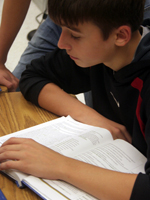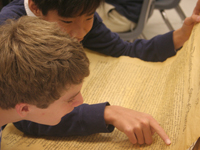The School's Council History Project (SCHP) was the largest innovation in history teaching in an English-speaking country and arguably the most successful. But few in this country have ever heard of it.
Founded at Great Britain's University of Leeds in 1973, SCHP grew by 1984 to embrace a quarter of all British high schools. By the time the project ended in 1988, SCHP had left an indelible mark on how history was taught in the United Kingdom.
Rote Learning vs. Historical Thinking
Project founders believed that traditional instruction might leave students with bodies of information, but little idea how to evaluate it. Students could commit to memory an agreed-upon narrative but they lacked a way of deciding whether it—or any other narrative—was compelling or true. The project's evaluator likened students from traditional history classes to those in a drama class, who could talk "sensibly about the separate scenes and characters of King Lear, but do not know what a play is."*
What is History?
The three-year curriculum began in the eighth grade with a course called "What is History?" This course introduced students to the idea of evidence, an important first step since many students had no idea that evidence played any role in understanding history. Other units exposed students to how historians reason about evidence, the role of primary sources in reaching historical conclusions, and how historical understanding depends on inference and imagination.
The curriculum favored depth over breath, engaging students in research projects and thrusting them into focused inquiries, on such topics as Elizabethan England, Britain in the years 18151851, the American West, and the Arab-lsraeli conflict. The curriculum included other topics because they helped students to see that their current conceptions were often poor guides to understanding the past. For example, studying the history of medicine over a long time span challenged students' ideas about causation and change and continuity.
Thinking Historically
The project evaluation showed that with well-planned curriculum and teachers who enacted the SCHP philosophy, adolescents could learn to reason about history in sophisticated ways. This finding contrasted sharply with overzealous Piagetian ideas that historical reasoning was beyond the ken of middle and high school students.
Getting Better at History
A lasting contribution of SCHP was its model of how adolescents "get better at history." In other words, what does it mean to make progress in historical understanding or become more sophisticated as a historical thinker? In his evaluation report, Denis Shemilt provided a rough model of how adolescents progress in historical reasoning:
- At Level I, adolescents view history as random events, with no inner logic other than their arrangement in chronological sequence.
- At Level II they view history with "an austere, Calvinistic logic," equating historical understanding with putting pieces of a puzzle into a preexisting form. They view history as an inevitable progression of events.
- At Level III, adolescents have a budding awareness of the difference between historical narratives and "the past"—and they begin to understand that narratives, based on selected pieces of surviving evidence, never fully capture the complexity of what occurred in a different time.
- At Level IV, adolescents start to see problems with a search for timeless explanatory principles and come to understand historical explanation as specific and rooted in particular epochs and contexts.
Assessment
SCHP also left behind an approach to assessment that differs from the multiple-choice tests familiar in this country. In SCHP examinations, students reviewed short, carefully selected documents (including photos and charts) and had to respond in a few short sentences. These assessments allowed Project leaders to not only track student progress but also to detect common student misconceptions that could be addressed in future instruction.

